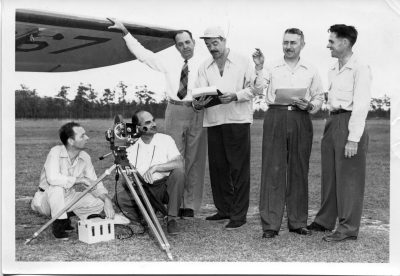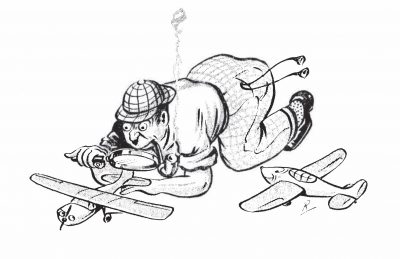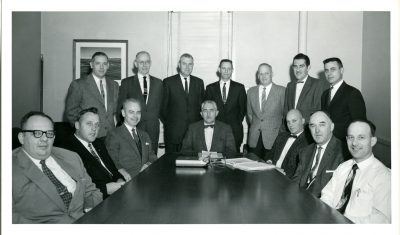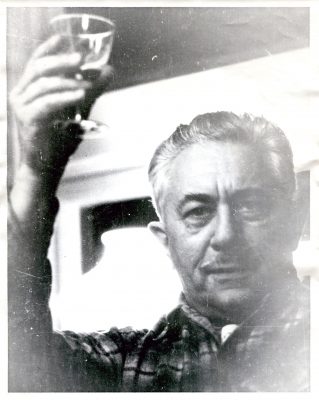
In honor of Aviation History Month, Veteran’s Day, and my father’s birthday, I’m sharing a peek at a treasure I unearthed when his widow died. I was asked by her executor if I would like his papers. What papers?, I thought. When he passed she became obsessed with ballroom dancing and turned his office into her dressing room for the lavish gowns she had custom-made. I was too young then to care about “papers”.
She had left his green metal filing cabinet untouched.
I skimmed the manila folders stuffed with photos and papers from his long career with the C.A.A./F.A.A. (1940-1969), deemed them of little interest to anyone outside of the family and a few hardcore aviation history buffs, and shipped them back home. I eventually took a closer look and was stunned by what I found.
My father—who had been born and raised in Brooklyn, NY, was the victim of anti-Semitism attacks, became a Lt. Col. in the Marines and easily swore—had written a monthly column for a national aviation maintenance magazine under the name The Inspector. That wasn’t the surprising part given he had started his career in hangars on Long Island in the 1930s (crossing paths with Charles Lindbergh and Amelia Earhart) and rose to a high position in the Federal Aviation Administration: Chief, Maintenance Division in Washington, D.C. He had been responsible for programs involving the safety and reliability of all civil aircraft in the United States.
What was shocking was that he had written these columns using a voice I had never heard from him.
Well, in five hard years of what the ads say is “pleasant, dignified work,” Jim Purdy was second to none at twirling the old wire wrench and making the ornery OX’s quit misbehaving. He also learned to straighten Curtiss Reed props over a tree stump with a 10-pound sledge, bugger Model T nuts and bolts to fit a Hisso and all manner of neat little tricks of the trade for those days.
1928 found old Jim a name to be reckoned with in the manly art of Zerk ’em and pull the push rods, pappy.
“The crackerbarrel style is tops,” his editor wrote. “Looking forward to future ‘bang-up’ articles.”
Crackerbarrel? My father?

The Inspector logo, artist unknown.
There were 22 articles in all, plus a detailed account in his usual voice of his stint in Anchorage, Alaska, starting in 1959 when it had just become a state. He was in charge of bringing Alaska’s rugged flying community up to F.A.A. standards.
Though I am thoroughly ignorant of aviation maintenance, I laughed often as I read The Inspector, bursting with pride and astonishment.
I also felt sad.
A memory surfaced of him telling me, offhandedly it seemed at the time, that he wished he had become a journalist. He said this when I had fallen in love with one, the Miami Herald columnist, Jay Maeder. He effortlessly won my father’s approval.
I didn’t think then that my father’s regret over not becoming a writer was serious given the success he’d had. I had not yet become a writer myself.
After reading these articles, I’m sure it was a deep frustration, a grief even, that he stayed in the corporate world to provide for his family instead of becoming the writer he longed to be. When he finally was published, he disguised his identity, probably because keeping his job depended on it.

George Weitz, center, at table. F.A.A. photo.
What struck me the most about this magnificent discovery? My parents wed in 1950, at the end of The Inspector era. My mother possessed an equally dry wit and love of a good turn of phrase. She was also an exceptional writer herself—something I didn’t learn until she was no longer here and I was going through her things as well. I’m sure she derived a huge kick from The Inspector and it became a potent arrow in my father’s quiver of seduction. Maybe the woman he was married to when he met my mother just didn’t get The Inspector. Thought it silly. I’ll never know. I do know that as a writer, someone loving your written words is key to their seducing you.
If The Inspector had not happened, my brother and I may not have happened.
Happy birthday, Colonel. Semper fi. You are deeply missed by many.
If you, dear reader, find an old issue of Aviation Maintenance & Operations Magazine from the late 1940s hidden in an attic with The Inspector byline, do let me know. As tempting as it may be to toss out dusty papers unearthed in a family member’s home, resist the urge. You never know what you’ll find.

Top photo: George Weitz, inspecting, second from right. Photographer and others in photo unknown.